2014 FIAT BRAVO window
[x] Cancel search: windowPage 59 of 275

WINDOW CLEANINGWINDSCREEN WASHER/WIPER
They can be operated only with the ignition key
turned to MAR-ON.
The right stalk can be moved to five different
positions fig. 37:A
windscreen wiper off.
Bintermittent operation.
With the stalk in position B, turn ring nut F to select
one of four different speeds for the intermittent
operation mode:
= intermittent low speed= slow intermittent operation.
= medium intermittent operation.
= fast intermittent operation.
C
continuous slow operation;
D
continuous fast operation;
Etemporary fast operation (unstable position).
Temporary fast operation position E is limited to the
time that the stalk is manually held in this position.
The stalk returns to position A when it is released,
automatically stopping the windscreen wipers.IMPORTANT With the windscreen wipers in use, if
reverse gear is engaged, the rear window wiper is
automatically activated.
fig. 37
F0Q0645
55GETTING TO
KNOW YOUR CARSAFETY
STARTING AND
DRIVING
WARNING LIGHTS
AND MESSAGES
IN AN EMERGENCY
SERVICING AND
MAINTENANCE
TECHNICAL
SPECIFICATIONS
INDEX
Page 61 of 275
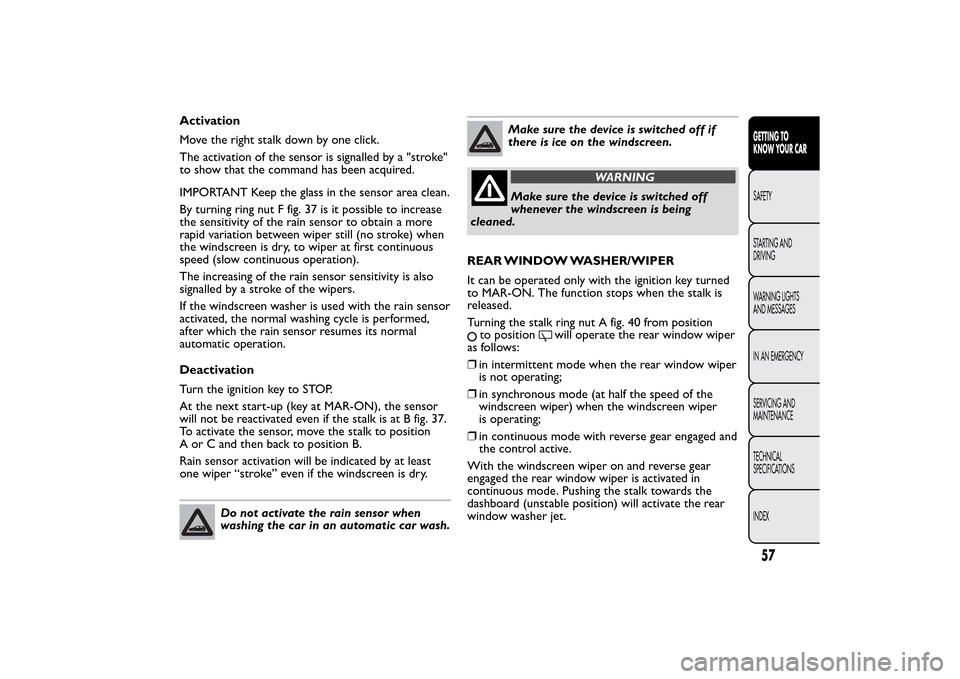
Activation
Move the right stalk down by one click.
The activation of the sensor is signalled by a "stroke"
to show that the command has been acquired.
IMPORTANT Keep the glass in the sensor area clean.
By turning ring nut F fig. 37 is it possible to increase
the sensitivity of the rain sensor to obtain a more
rapid variation between wiper still (no stroke) when
the windscreen is dry, to wiper at first continuous
speed (slow continuous operation).
The increasing of the rain sensor sensitivity is also
signalled by a stroke of the wipers.
If the windscreen washer is used with the rain sensor
activated, the normal washing cycle is performed,
after which the rain sensor resumes its normal
automatic operation.
Deactivation
Turn the ignition key to STOP.
At the next start-up (key at MAR-ON), the sensor
will not be reactivated even if the stalk is at B fig. 37.
To activate the sensor, move the stalk to position
A or C and then back to position B.
Rain sensor activation will be indicated by at least
one wiper “stroke” even if the windscreen is dry.
Do not activate the rain sensor when
washing the car in an automatic car wash.
Make sure the device is switched off if
there is ice on the windscreen.
WARNING
Make sure the device is switched off
whenever the windscreen is being
cleaned.
REAR WINDOW WASHER/WIPER
It can be operated only with the ignition key turned
to MAR-ON. The function stops when the stalk is
released.
Turning the stalk ring nut A fig. 40 from position
to position
will operate the rear window wiper
as follows:
❒in intermittent mode when the rear window wiper
is not operating;
❒in synchronous mode (at half the speed of the
windscreen wiper) when the windscreen wiper
is operating;
❒in continuous mode with reverse gear engaged and
the control active.
With the windscreen wiper on and reverse gear
engaged the rear window wiper is activated in
continuous mode. Pushing the stalk towards the
dashboard (unstable position) will activate the rear
window washer jet.
57GETTING TO
KNOW YOUR CARSAFETY
STARTING AND
DRIVING
WARNING LIGHTS
AND MESSAGES
IN AN EMERGENCY
SERVICING AND
MAINTENANCE
TECHNICAL
SPECIFICATIONS
INDEX
Page 62 of 275
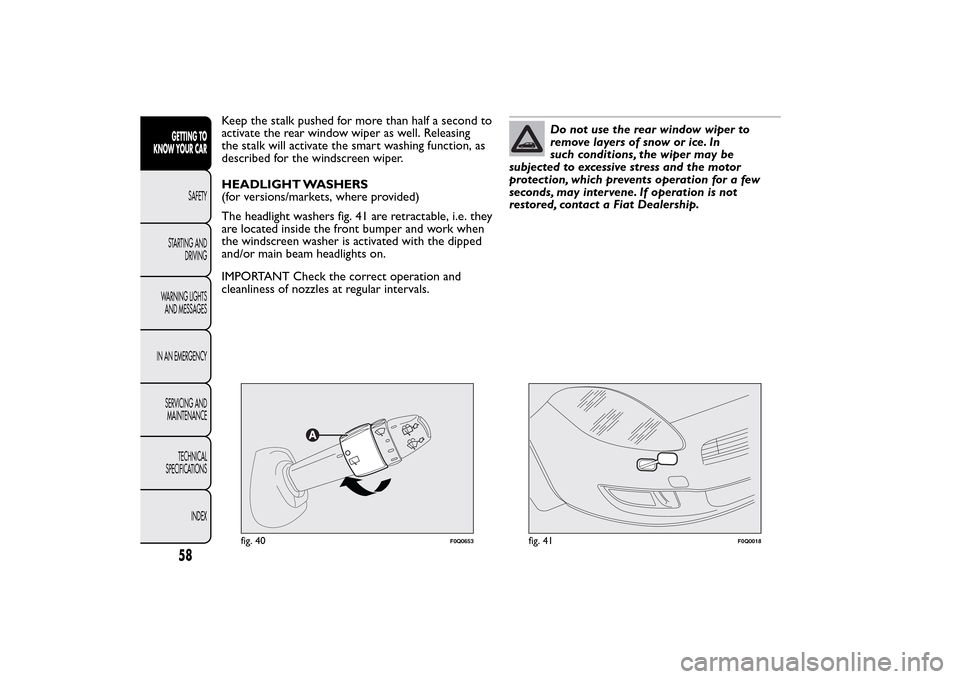
Keep the stalk pushed for more than half a second to
activate the rear window wiper as well. Releasing
the stalk will activate the smart washing function, as
described for the windscreen wiper.
HEADLIGHT WASHERS
(for versions/markets, where provided)
The headlight washers fig. 41 are retractable, i.e. they
are located inside the front bumper and work when
the windscreen washer is activated with the dipped
and/or main beam headlights on.
IMPORTANT Check the correct operation and
cleanliness of nozzles at regular intervals.
Do not use the rear window wiper to
removelayersofsnoworice.In
such conditions, the wiper may be
subjected to excessive stress and the motor
protection, which prevents operation for a few
seconds, may intervene. If operation is not
restored, contact a Fiat Dealership.
fig. 40
F0Q0653
fig. 41
F0Q0018
58GETTING TO
KNOW YOUR CAR
SAFETY
STARTING AND
DRIVING
WARNING LIGHTS
AND MESSAGES
IN AN EMERGENCY
SERVICING AND
MAINTENANCE
TECHNICAL
SPECIFICATIONS
INDEX
Page 81 of 275

WARNING
Do not activate the child lock device if
the rear doors emergency lock device
is already activated. If both have been
activated, you need to use the interior handle to
disengage the rear doors emergency locking
system and then open the door from the
outside.
ELECTRIC WINDOWSThey are fitted with a security system that can detect
the presence of an obstacle whilst the window is
closing; when this happens, the system kicks in and
the movement of the glass is immediately reversed.
IMPORTANT In the event that the anti-crushing
function is activated 5 times in only 1 minute, the
system will automatically enter the “recovery” mode
(self-protection). This condition is apparent from
the window closing in stages.
If this occurs, restore the system as follows:
❒open the windows;
or
❒turn the ignition key to the STOP position and
then to MAR-ON.
If no malfunction is present, the window returns to
its normal operation automatically.
IMPORTANT With the ignition key at STOP or
removed, the electric windows remain activated for
about two minutes and are deactivated as soon as
a door is opened.
WARNING
The system conforms to the 2000/4/EC
standard concerning the safety of
passengers leaning out of the passenger
compartment .
77GETTING TO
KNOW YOUR CARSAFETY
STARTING AND
DRIVING
WARNING LIGHTS
AND MESSAGES
IN AN EMERGENCY
SERVICING AND
MAINTENANCE
TECHNICAL
SPECIFICATIONS
INDEX
Page 82 of 275

IMPORTANT On some versions, when the
button
on the key with remote control is pressed for longer
than 2 seconds the windows will open, whilst if the
button is pressed for longer than 2 seconds the
windows will close.
CONTROLS
Driver side front door fig. 71
Buttons have been provided on the driver's door
panel to control the following functions with the
ignition key turned to MAR-ON:A
opening/closing front left window; “continuous
automatic” operation during window opening/
closing stage;
Bopening/closing front right window; “continuous
automatic” operation during window opening/
closing stage;
C
enabling/disabling of rear door electric window
controls;
D
opening/closing rear left window (for versions/
markets, where provided); “continuous automatic”
operation during window opening/closing stage;
Eopening/closing rear right window (for versions/
markets, where provided); “continuous automatic”
operation during window opening/closing stage.
Window opening
Push the buttons to open/close the desired window.
When one of the two buttons is pressed briefly,
the window moves in "stages"; if the button is held
down, "continuous automatic" operation is activated.
If the button is pressed again the window will stop
in its current position.
Window closing
Lift the buttons to close the desired window.
The window closing stage occurs following the same
logics described for the opening stage.
fig. 71
F0Q0622
78GETTING TO
KNOW YOUR CAR
SAFETY
STARTING AND
DRIVING
WARNING LIGHTS
AND MESSAGES
IN AN EMERGENCY
SERVICING AND
MAINTENANCE
TECHNICAL
SPECIFICATIONS
INDEX
Page 83 of 275
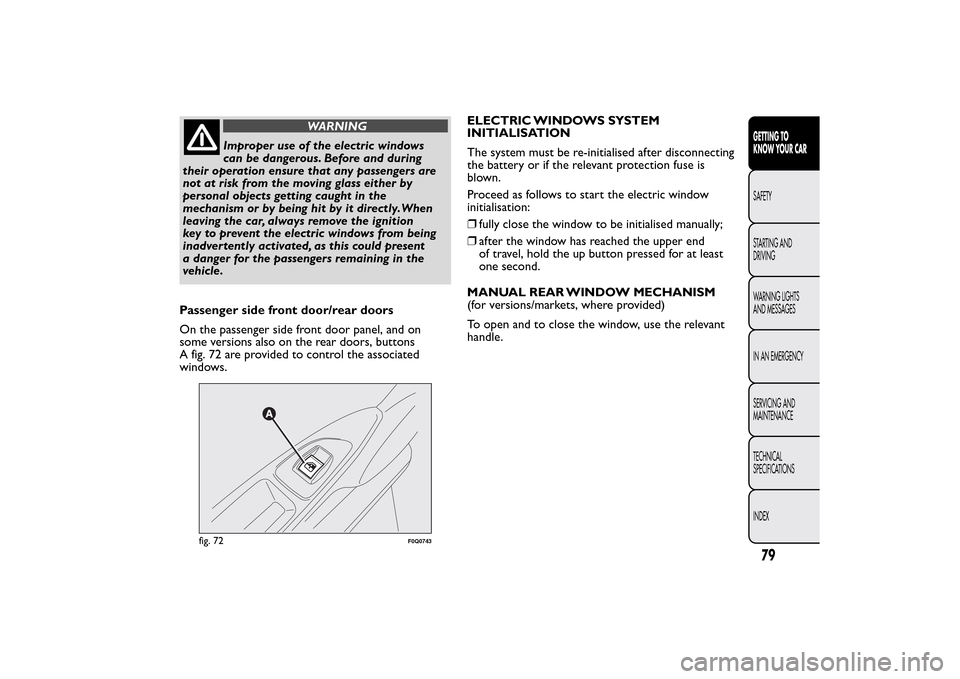
WARNING
Improper use of the electric windows
can be dangerous. Before and during
their operation ensure that any passengers are
not at risk from the moving glass either by
personal objects getting caught in the
mechanism or by being hit by it directly.When
leaving the car, always remove the ignition
key to prevent the electric windows from being
inadvertently activated, as this could present
a danger for the passengers remaining in the
vehicle.
Passenger side front door/rear doors
On the passenger side front door panel, and on
some versions also on the rear doors, buttons
A fig. 72 are provided to control the associated
windows.ELECTRIC WINDOWS SYSTEM
INITIALISATION
The system must be re-initialised after disconnecting
the battery or if the relevant protection fuse is
blown.
Proceed as follows to start the electric window
initialisation:
❒fully close the window to be initialised manually;
❒after the window has reached the upper end
of travel, hold the up button pressed for at least
one second.
MANUAL REAR WINDOW MECHANISM
(for versions/markets, where provided)
To open and to close the window, use the relevant
handle.
fig. 72
F0Q0743
79GETTING TO
KNOW YOUR CARSAFETY
STARTING AND
DRIVING
WARNING LIGHTS
AND MESSAGES
IN AN EMERGENCY
SERVICING AND
MAINTENANCE
TECHNICAL
SPECIFICATIONS
INDEX
Page 135 of 275
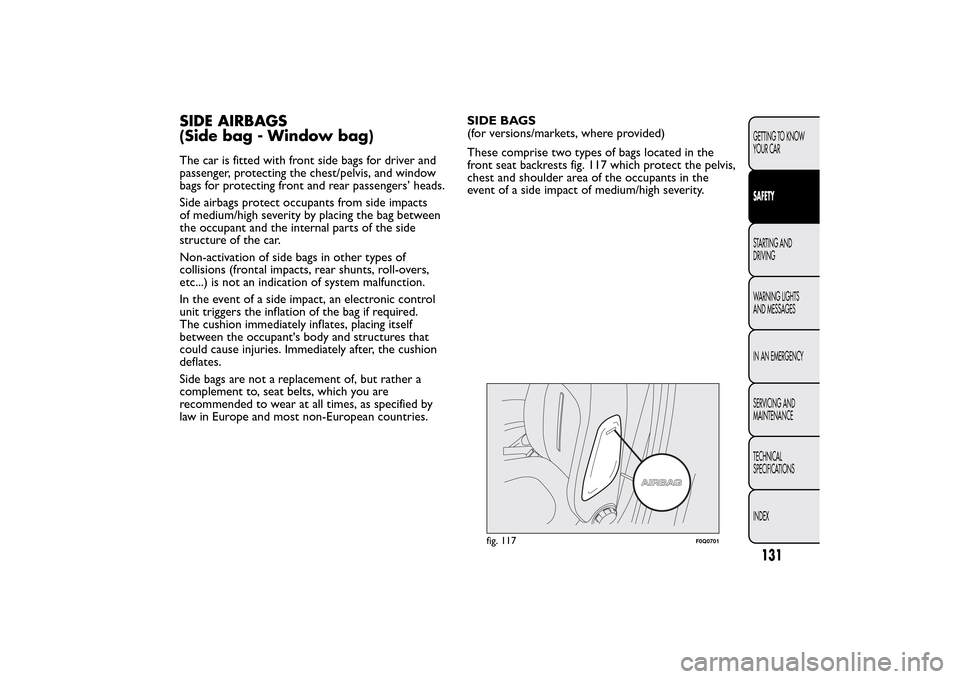
SIDE AIRBAGS
(Side bag - Window bag)The car is fitted with front side bags for driver and
passenger, protecting the chest/pelvis, and window
bags for protecting front and rear passengers’ heads.
Side airbags protect occupants from side impacts
of medium/high severity by placing the bag between
the occupant and the internal parts of the side
structure of the car.
Non-activation of side bags in other types of
collisions (frontal impacts, rear shunts, roll-overs,
etc...) is not an indication of system malfunction.
In the event of a side impact, an electronic control
unit triggers the inflation of the bag if required.
The cushion immediately inflates, placing itself
between the occupant's body and structures that
could cause injuries. Immediately after, the cushion
deflates.
Side bags are not a replacement of, but rather a
complement to, seat belts, which you are
recommended to wear at all times, as specified by
law in Europe and most non-European countries.SIDE BAGS
(for versions/markets, where provided)
These comprise two types of bags located in the
front seat backrests fig. 117 which protect the pelvis,
chest and shoulder area of the occupants in the
event of a side impact of medium/high severity.
fig. 117
F0Q0701
131GETTING TO KNOW
YOUR CARSAFETYSTARTING AND
DRIVING
WARNING LIGHTS
AND MESSAGES
IN AN EMERGENCY
SERVICING AND
MAINTENANCE
TECHNICAL
SPECIFICATIONS
INDEX
Page 136 of 275
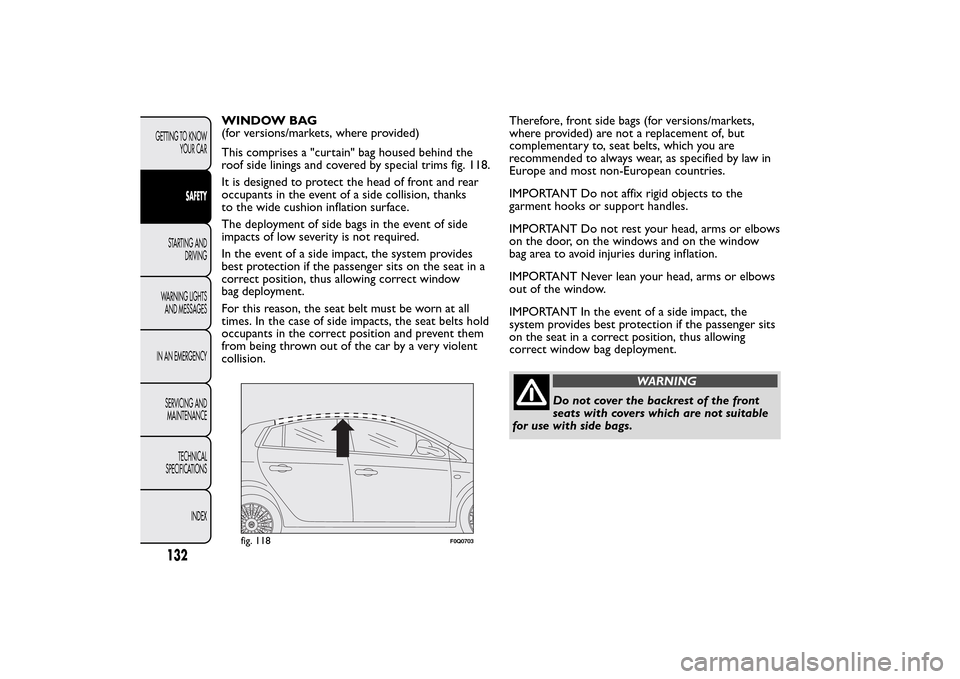
WINDOW BAG
(for versions/markets, where provided)
This comprises a "curtain" bag housed behind the
roof side linings and covered by special trims fig. 118.
It is designed to protect the head of front and rear
occupants in the event of a side collision, thanks
to the wide cushion inflation surface.
The deployment of side bags in the event of side
impacts of low severity is not required.
In the event of a side impact, the system provides
best protection if the passenger sits on the seat in a
correct position, thus allowing correct window
bag deployment.
For this reason, the seat belt must be worn at all
times. In the case of side impacts, the seat belts hold
occupants in the correct position and prevent them
from being thrown out of the car by a very violent
collision.Therefore, front side bags (for versions/markets,
where provided) are not a replacement of, but
complementary to, seat belts, which you are
recommended to always wear, as specified by law in
Europe and most non-European countries.
IMPORTANT Do not affix rigid objects to the
garment hooks or support handles.
IMPORTANT Do not rest your head, arms or elbows
on the door, on the windows and on the window
bag area to avoid injuries during inflation.
IMPORTANT Never lean your head, arms or elbows
out of the window.
IMPORTANT In the event of a side impact, the
system provides best protection if the passenger sits
on the seat in a correct position, thus allowing
correct window bag deployment.
WARNING
Do not cover the backrest of the front
seats with covers which are not suitable
for use with side bags.
fig. 118
F0Q0703
132GETTING TO KNOW
YOUR CAR
SAFETY
STARTING AND
DRIVING
WARNING LIGHTS
AND MESSAGES
IN AN EMERGENCY
SERVICING AND
MAINTENANCE
TECHNICAL
SPECIFICATIONS
INDEX